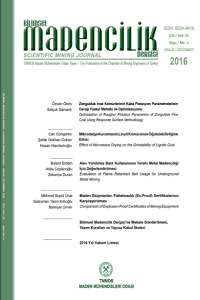Ravil Zinnurovich NAFİKOV, Victor Evgenievich KİSLYAKOV, Aleksandr Konstantinovich KİRSANOV, Ekaterina Vasilevna SHEVNİNA, Anastasiya Olegovna IVANCHUK, Pavel Viktorovich KATYSHEV, Umardzhon Riezidinovich TESHAEV
Uzak Kuzeydeki Plaser Mevduatlarının Tarama Teknolojisi
Yazarlar, sıfırın altındaki hava sıcaklıklarında çalışırken tarama performansını düşürme problemini göz önünde bulundururlar. Bu sorun özellikle, tarama mevsiminin iklim koşullarıyla sınırlı olduğu Uzak Kuzey'de bulunan yataklar için geçerlidir. Sıfırın altındaki hava sıcaklıkları döneminde, tarama yapısının buzlanması nedeniyle tarama performansı önemli ölçüde azalır. Sonuç olarak, çalışma için uygun koşullar oluşana kadar tarama işlemleri sonlandırılır. Bu bağlamda, yazarlar, çağdaş inşaat malzemelerinden yapılmış bir hangar ile açık ocak madeni izole etmek için bir yöntem önermektedir. Çeşitli avantajlara sahip hücresel polikarbonat, yalıtkan tarama çalışmaları için en umut verici malzeme olarak seçilmiştir. Makale, tarama mevsimini uzatmak için önerilen yöntem için teknik ve teknolojik çözümler sunmaktadır. Farklı büyüklükteki taramalar için bir tarama hangarının maliyeti ve hareketinin yıllık maliyeti hesaplanır. Değerleri tarama tipine ve kumdaki altın içeriğine bağlı olan, taramanın optimal manevra açısını ve tek yüzün genişliğini belirlemek için bir yöntem geliştirilmiştir. Tarama hangarlarının alanları grafik-analitik yöntemle belirlenir. Makale, yıl boyunca bir tarama hangarındaki hava sıcaklığı dinamiklerinin bir örneğini sunmakta ve madencilik sezonunun süresini belirlemektedir.
Anahtar Kelimeler:
plaser tortusu, plaser altın, tarama, madencilik sezonu, tarama hangarı, kış mevsimi, Uzak Kuzey, üretkenlik
Dredging Technology of Placer Deposits in the Far North
The authors consider the problem of reducing the dredge performance when operating at subzero air temperatures. This problem is particularly relevant for deposits located in the Far North, where the dredging season is limited by climatic conditions. During the period of subzero air temperatures dredge performance decreases significantly due to the icing of dredge structure. In consequence, dredging operations are terminated until the occurrence of favorable conditions for work. In this regard, the authors propose a method for isolating the open-pit mine with a hangar made of contemporary construction materials. Cellular polycarbonate, which has several advantages, was chosen as the most promising material for insulating dredging works. The article offers the technical and technological solutions for the proposed method of extending the dredging season. The costs of a dredge hangar for dredges of different sizes and the annual cost of its movement are calculated. A method has been developed for determining the optimal maneuvering angle of the dredge and the width of the single face, whose values depend on the type of dredge and the gold content in the sand. The areas of dredge hangars are determined by the graphical-analytic method. The article presents an example of the air temperature dynamics in a dredge hangar during the year, as well as determines the duration of the mining season.
Keywords:
placer deposit, placer gold, dredge, mining season, dredging hangar, winter season, Far North, productivity,
___
- Belov, S. V. 2011. Technogenic gold deposits: state and development prospects. Gold Mining Industry. 4, 14-21.
- Garnett, R. H. T. 2015. Graphical representation of production results versus estimates in placer mining. Transactions of the Institutions of Mining and Metallurgy Section B: Applied Earth Science. 124(3), 175-190.
- Kashirtseva, A. P. 2019. Evaluation of capital expenditures at different stages of implementation of investment projects of gold mining enterprises. Modern Economy Success (International Scientific Research Journal). 2, 79-82.
- Kislyakov, V. E. and Nafikov, R. Z. 2016. Parameters of the insulating structure at dredging at subzero temperatures. Bulletin of the Tula State University. Earth Sciences. 2, 95-101.
- Kislyakov, V. E., Nafikov, R. Z., Vokin, V. N. and Bakhtiguzin, A. A. 2017. Investigation of heat transfer in the isolated space of the dredge section. Achievements of Modern Natural Science. 8, 89-93.
- Kislyakov, V. E., Nafikov, R. Z., Vokin, V. N., Veretenova, T. A. and Bakhtiguzin, A. A. 2018. Temperature regime of water in the dredge cross-section during the development of frozen soils. Achievements of Modern Natural Science. 12-2, 353-357.
- Kostromin, M. V., Yurgenson, G. A. and Pozlutko, S. G. 2007. Problems of dredge development of continental placers. Novosibirsk: Nauka, 180 p.
- Leshkov, V. G. 1985. Development of placer deposits. Moscow: Nedra, 568 p
- Nurok, G. A. 1970. Hydro-mechanization of open-pit developments. Moscow: Nedra, 584 p.
- Rafkatovich, A. K. and Mironova, K. V. 2018. Methods for the reduction of loss and optimization processes of open-pit mining operations when mining man-made deposits formed by sections. Journal of Engineering and Applied Sciences. 13(7), 1624-1631.
- Ryzhov, S. V. 2020. Substantiation of the production capacity structure of a gold mining enterprise at various stages of the open-pit mining development of operations. Bulletin of the Tula State University. Earth Sciences. 1, 458-470.
- Shorokhov, S. M. 1973. Technology and complex mechanization of the placer deposits development. Moscow: Nedra, 766 p.
- Talgamer, B. L. and Chemezov, V. V. 2012. Assessment of technogenic placers and methods for determining their stocks. Bulletin of the Irkutsk State Technical University (IrGTU). 12(71), 126-130.
- Yershov, V. A. 2010. Purposeful transformation of placer deposits in dredging. Mining Industry. 5, 70-72.
- Zhang, T., Dong, Y., Yang, C., Guan, Q. and Gao, J. 2019. Bedrock samples from the Chukchi borderland, arctic ocean-first Chinese dredge in the polar regions. Acta Oceanologica Sinica. 38(11), 162-164.
- Zhuravlev, V. V. 2018. Improving the strategic management model of gold-mining enterprises in Russia in the context of unstable economic development. Bulletin of the South Ural State University. Series: Economics and Management. 2, 145-154.
- ISSN: 2564-7024
- Başlangıç: 1960
- Yayıncı: TMMOB Maden Mühendisleri Odası
Sayıdaki Diğer Makaleler
TTK’DA UYGULANAN ÖN GERİLMELİ AHŞAP DOMUZDAMI SİSTEMİ
Esma Hacer EVKAYA, Erdoğan KAYMAKÇI
Uzak Kuzeydeki Plaser Mevduatlarının Tarama Teknolojisi
Ravil Zinnurovich NAFİKOV, Victor Evgenievich KİSLYAKOV, Aleksandr Konstantinovich KİRSANOV, Ekaterina Vasilevna SHEVNİNA, Anastasiya Olegovna IVANCHUK, Pavel Viktorovich KATYSHEV, Umardzhon Riezidinovich TESHAEV
Sedanur BAŞ, Taki GÜLER, Selçuk AKTÜRK
Kritik Hammaddelerin Geri Dönüşüm ile Döngüsel Ekonomiye Kazandırılması
Ata AKÇIL, Ceren ERÜST ÜNAL, Mediha Demet OKUDAN
Turbulence models and simulation method in the CFD simulation of 75-mm hydrocyclone
